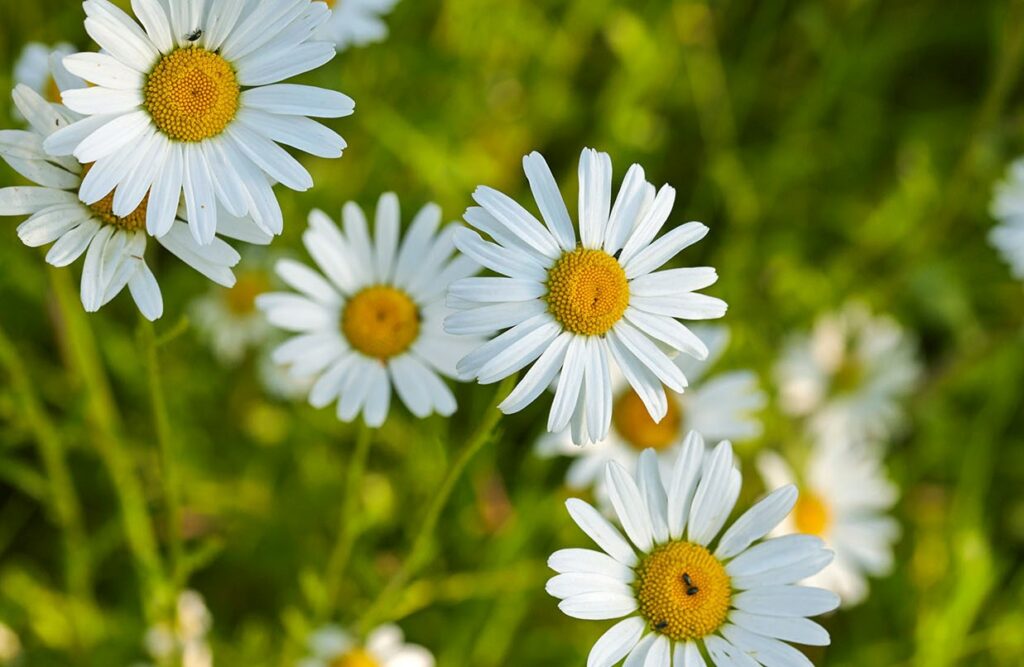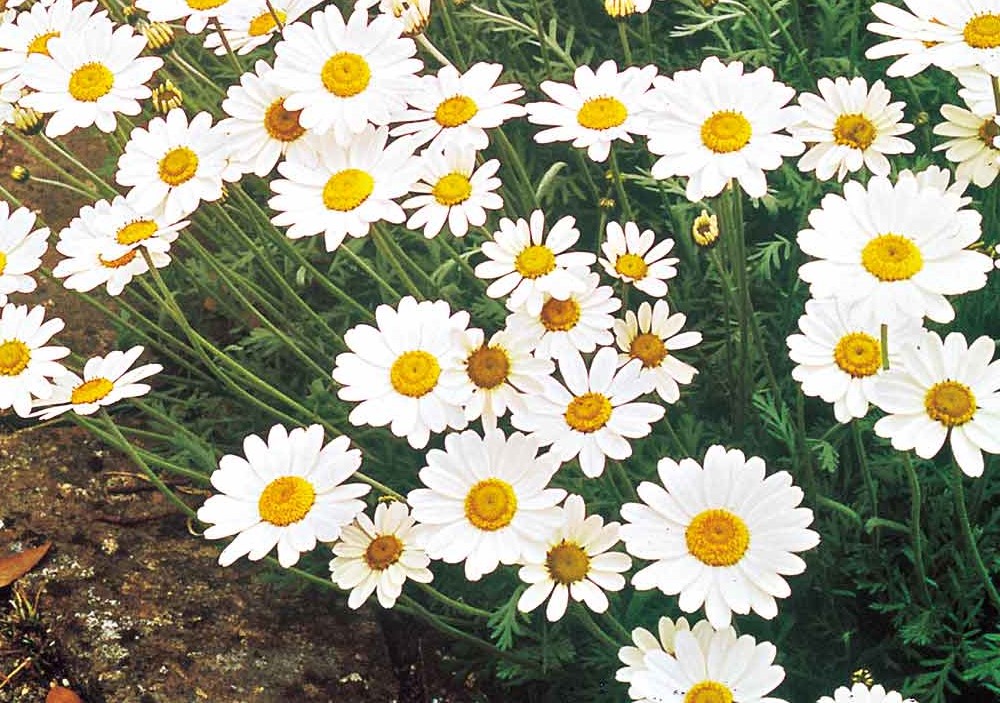The Oxeye Daisy (Leucanthemum vulgare), also known as the Moon Daisy, Field Daisy, or Poverty Daisy, is a widely recognised wildflower native to Europe and Asia. A common plant in temperate regions, it has become naturalised in North America, where it often grows in a variety of plant communities, including pastures, grasslands, and roadsides. As an ornamental plant, the Oxeye Daisy is a popular choice for gardens due to its bright, cheerful appearance and resilience in a wide range of conditions. In this article, we will explore the characteristics, growth habits, ecological significance, and potential challenges of this classic daisy wildflower.
Plant Characteristics and Identification
The Oxeye Daisy is a grassland perennial with a typical daisy-like appearance, featuring white, ray-like petals surrounding a yellow centre. This yellow disc is made up of numerous small, tubular yellow disc florets. The flower heads, which may resemble the larger Shasta Daisy, sit atop slender stems that can reach heights of 1 to 3 feet. The leaves of the Oxeye Daisy are dark green and coarsely toothed, with basal leaves being the largest and stem leaves being alternate and smaller. The base leaves are spoon-shaped, while the stem leaves are lanceolate and sessile.

Growing Conditions and Soil Preferences
The Oxeye Daisy is highly adaptable and can thrive in a wide range of conditions, from full sun to partial shade. It is most commonly found in average, well-draining soil but can also grow in alkaline soils and poor, nutrient-deficient soils. These plants have a preference for a sunny spot, though they can tolerate deeper shade and even afternoon shade in hotter climates. As such, they are often found in subalpine grasslands and typical grassland environments.
In richer soils, Oxeye Daisies can grow more vigorously, producing larger flower heads and more robust foliage. However, they can also tolerate less fertile conditions, which contributes to their wide-ranging success as a wildflower. When it comes to moisture, the Oxeye Daisy can grow in a variety of soil types, from moist to well-draining soils, as long as the plant does not become waterlogged.
Seed Propagation and Dispersal
To propagate Oxeye Daisies, seeds can be sown in moist seed compost or mixed with other wildflower seeds in a seed mix. Creating a seed bed with a variety of plant species encourages the development of a diverse and attractive grassland habitat. It is important to sow the seeds in the perfect condition for planting, ensuring that the soil is neither too wet nor too dry. The seeds should be sown thinly and evenly to prevent overcrowding and competition between seedlings.
Animals, including birds and insects, play a crucial role in seed transportation, helping the daisy spread across a wide range of habitats. Wind can also be an important factor in dispersing the seeds, allowing them to travel long distances from the parent plant. This ability to spread readily contributes to the Oxeye Daisy’s success as a common plant in various environments.

Weed Status and Environmental Impact
While the Oxeye Daisy is valued as an ornamental plant for gardens and as a native wildflower in its original range, it has also become an environmental weed in some regions where it has been introduced. As widespread weeds, Oxeye Daisies are classified as both annual and perennial weeds. Their rapid growth and ability to outcompete native plants can lead to degraded pastures and a loss of soil quality, contributing to soil erosion and a decline in soil organic content.
In some areas, the Oxeye Daisy has been identified as a target weed for control measures, with land managers employing various strategies to reduce its impact on native plant communities and ecosystems. These strategies may include mechanical removal, targeted herbicides, or the introduction of biological control agents. It is essential to balance the management of the Oxeye Daisy as a weed with its role as a valuable ornamental plant and component of native wildflower habitats.

Allergies To Daisies and Ecological Significance
Some people may experience allergies to daisies, including the Oxeye Daisy, due to the pollen produced by the yellow disc florets. However, despite this drawback, the Oxeye Daisy remains an ecologically significant plant. It serves as a food plant for various insects and as a caterpillar food plant for some butterfly species. The flowers provide nectar and pollen to a wide range of pollinators, including bees, butterflies, and hoverflies, thus playing an essential role in the ecosystem.
Moreover, the Oxeye Daisy’s presence in grasslands and pastures can benefit other plants and animals by providing shelter and habitat. For example, the dense foliage of mature plants can offer cover for small mammals, birds, and insects, while the flowers attract pollinators, which in turn help to maintain the overall health and biodiversity of the ecosystem.
Cultivation In Gardens and Landscapes
In addition to its role as a wildflower, the Oxeye Daisy is a popular choice as an ornamental plant for gardens and landscapes. Its cheerful, bright appearance, combined with its adaptability to a range of conditions, makes it a versatile and attractive addition to any garden. When grown in an appropriate setting, the Oxeye Daisy can contribute to a vibrant, biodiverse landscape that supports a wide range of wildlife.
To grow Oxeye Daisies in a garden setting, they should be planted in a sunny spot with average, well-draining soil. Although they can tolerate a range of soil types, they will perform best in conditions that mimic their natural habitat. When planting, it’s essential to provide enough space between plants to ensure proper air circulation and prevent the spread of leaf spots or other diseases. Regular deadheading of spent flower heads can also promote the production of more blooms and prolong the flowering season.
Conclusion
The Oxeye Daisy is a versatile and adaptable plant, thriving in a variety of soil types and environmental conditions. Though it can be considered a weed in some regions, it remains a popular ornamental plant for gardens and an essential component of native wildflower habitats. By understanding its characteristics, growth habits, ecological significance, and potential challenges, we can better appreciate and manage this iconic wildflower in our landscapes. As a symbol of beauty and resilience, the Oxeye Daisy continues to hold a special place in the hearts of nature enthusiasts and gardeners alike.
Sources and References
- Armitage, A. M. (2006). Armitage’s Native Plants for North American Gardens. Timber Press. ISBN 978-0881927607.
- Blamey, M., & Grey-Wilson, C. (2005). Wild Flowers of Britain and Northern Europe. London: HarperCollins Publishers. ISBN 978-0007183890.
- Chrysanthemum Leucanthemum – rhs.org.uk

Ash is a contributing author who has been writing about wildlife for as long as he can remember. He has a vast knowledge of many different types of animals, from the tiniest shrews to the great whales that live in the deepest oceans.
